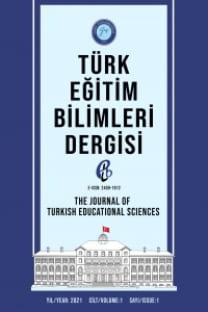KİMYA ÖĞRETMEN ADAYLARININ ATOMLA İLGİLİ BAZI KAVRAMLARI ANLAMA DERECELERİNİN BELİRLENMESİ
Kimya eğitimi, atomun yapısı ve öğretimi, atom kavramı, yanlış kavramlar
DETERMINATION OF THE LEVELS OF PERCEPTION OF SOME OF THE CONCEPTS RELATED ATOM BY THE PRE SERVICE CHEMISTRY TEACHERS
Chemistry education, the structure and teaching of atom, the concept of atom, misconceptions,
___
- Abraham, M., Grybowski, E., Marek, A. (1992). Understandings and misunderstandings of eight graders of five chemistry concepts found in textbooks. Journal of Research in Science Teaching, 29, 105 -120.
- Anderson, R., Mitchner, C. (1994). Research on science teacher education. In D. Gabel (Ed.), Handbook of Research On Science Teaching And Learning . New York: Macmillian.
- Barba, R., Rubba, P. (1992). A comparison of preservice and in-service earth and space teachers’ general mental abilities, content knowledge and problem solving skills. Journal of Research in Science Teaching, 29, 1021 -1035.
- BauJaoude, S. (1991). A study of the nature of students’ understandings about the concept of burning. Journal of Research in Science Teaching, 28, 689 -704.
- Bendall, S., Galili, I. (1993). Prospective elementary teachers’ prior knowledge about light. Journal of Research in Science Teaching, 30(9), 1169 -1187.
- Campbell, E. (2000). Do chemistry students understand chemistry? NEACT Journal, 19(1), 16-20.
- Copeland, R. (1984). How children learn mathematics: teaching ımplications of piaget’s research. (4th Ed.).New York: Macmillan.
- Earlier, Renner, J. , Brumby, M., Shephered, D. (1981). Why are there no dinosaurs in oklahoma? The Science Teacher, 48, 135 -143.
- Grubern, H. , Vonéche, J. (Eds.). (1997). The essential piaget. London: Roultledge and Kegan Paul.
- Haidar, A., Abraham, M. (1991). A comparison of applied and theoretical knowledge of concepts based on the particulate nature of matter. Journal of Research in Science Teaching, 28, 919-938.
- Lederman, N., Gess-Newsome, J., Latz, M. (1994). The nature and development of preservice science teachers’ conceptions of subject matter and pedagogy. Journal of Research in Science Teaching, 31, 129-146.
- McDiarmind, C., Anderson, R. (1989). Teachers’ perspective: developing and ımplementing an sts curriculum. Journal of Research in Science Teaching, 26, 351-369.
- Meriç, G. (2001). İlköğretim fen bilgisi öğretmen adaylarının mol kavramı konusundaki kavram yanılgılarının tespiti ve konunun öğretimine ilişkin öneriler. Yüksek lisans tezi, Gazi Üniversitesi Eğitim Bilimleri Enstitüsü, Ankara.
- Mortimer, C. E. (1999). Modern üniversite kimyası (Cilt -1). İstanbul: Çağlayan Kitabevi.
- Nakleh, M. B. (1992). Why some students don’t learn chemistry: chemical misconceptions. Journal of Chemical Education, 69(3). 191 -196.
- Novick, S., Nussbaum, J. (1981). Pupils’ understanding of the particulate nature of matter: a cross-age study. Science Education, 65(2). 187 -196.
- Piaget, J., Inhelder, B. (1974). The child’s construction of quantities. London: Routledge, Kegan Paul.
- Sewell, A. (2002). Cells and atoms—are they related? Australian Science Teachers’ Journal, 48(2). 26-30.
- Simpson, W. (1986). Understandings and misunderstandings of biological concepts of students attending large high schools and students attending small high schools. Unpublished master’s thesis, Universty of Oklahoma, Norman.
- Sutan, A., McHugh, A. (1994). Atoms family. Science Scope, 18(2). 22 -26.
- Tsaparlis, G. (1997). Atomic orbitals, molecular orbitals and related concepts: conceptual difficulties among chemistry students. Research in Science Education, 27(2). 271-287.
- Tunalı, N. K., Özkar, S. (1997). Anorganik kimya (3. Baskı). Ankara: Gazi Kitabevi.
- Başlangıç: 2003
- Yayıncı: ANKARA HACI BAYRAM VELİ ÜNİVERSİTESİ
Fen Bilgisi Öğretmen Adaylarının Bilimsel Bilgi ve Yöntem Algıları
Kimya Öğretmen Adaylarının Atomla İlgili Bazı Kavramları Anlama Derecelerinin Belirlenmesi
BİLİŞSEL DEĞERLENDİRME ÖLÇEĞİ’NİN UYARLANMASI: GEÇERLİK VE GÜVENİRLİK ÇALIŞMALARI
ÇOK ALANLI SANAT EĞİTİMİ YÖNTEMİNİN İLKÖĞRETİM 6. SINIF RESİM-İŞ DERSİNDE ÖĞRENCİ TUTUMUNA ETKİSİ
BOŞLUK TAMAMLAMA TESTİNİN OKUMA DÜZEYİNİ VE OKUNABİLİRLİĞİ ÖLÇMEDE KULLANILMASI
ÇOKLU ZEKÂ KURAMI DESTEKLİ EĞİTİMİN DOKUZUNCU SINIF COĞRAFYA DERSLERİNDE BAŞARIYA ETKİSİ
SOSYAL BİLGİLER ADAY ÖĞRETMENLERİNİN SINIF İÇİ ÖĞRETİM YETERLİKLERİ (Kırşehir Örneği)
Boşluk Tamamlama Testinin Okuma Düzeyini ve Okunabilirliği Ölçmede Kullanılması
Sosyal Bilgiler Aday Öğretmenlerinin Sınıf İçi Öğretim Yeterlikleri (Kırşehir Örneği)
